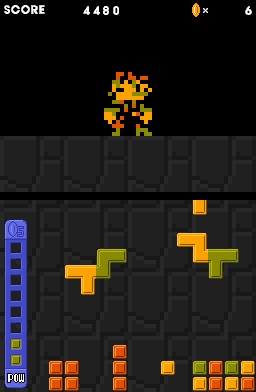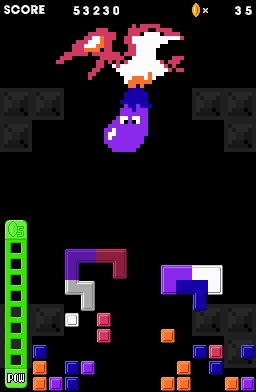Blocks rain from the sky, blotting out the sun with their odd shapes and vivid colors. Your only hope to survive this onslaught is to match colors, banishing these blocks with strings of carefully constructed combos. But they just keep falling, faster and faster, until the screen is a blur of colors and you end up buried under the unrelenting mass. It's a formula that has been imitated and tweaked countless times since Tetris introduced the world to the horrors of geometric shapes. Art Style: Pictobits is unique, taking advantage of the touch screen to make block removal feel fresh, but it lacks the addictive quality that keeps you glued to the screen for hours, or even weeks, at a time. At only 500 DSi points ($5), it's an affordable way to check out another twist to the classic formula, but Pictobits doesn't have the verve to become a classic in its own right.
Pictobits isn't as immediately accessible as other games in the genre, so the six-stage tutorial is necessary to get a handle on how you must dispose of the falling blocks. The levels begin with a few rows of blocks on the bottom of the screen that serve as your tools of disposal for the incoming waves. When you tap any of these 1x1 pieces, they get stored in your queue, and you can deploy these blocks by tapping any blank space on the screen. To destroy falling blocks, you must match four or more colors in a row or form a 2x2 square. Matched blocks disappear, and blocks that you don't manage to get rid of crash to the bottom of the screen and split into individual pieces, ripe for the gathering. As you destroy blocks, a picture of a Nintendo character slowly takes shape on the top screen, and you pass the stage when the picture is completed. There are a few twists to this formula as the game progresses, such as certain blocks that cannot be picked up once they hit the ground, but the basic tap-and-bust structure continues throughout.
The first couple of levels ease you into the touch-based gameplay, slowly streaming a predictable pattern of blocks to get you used to juggling colors and stringing together combos. But the difficulty quickly ramps up and, depending on how adept you are at block removal, it could take only a few levels before you hit a wall. The simple shapes that were so easy to dispose of in the beginning quickly become larger and more abstract, making it difficult to completely remove them before they crash into the ground. As the speed ramps up, some problems also surface that make it even more challenging to destroy the mass of blocks. The controls are not precise enough when the pressure is on, which makes it all too easy to pick up the wrong color or place a block in an inopportune location. The different colors in certain stages are also unnecessarily similar; thus, choosing the correct color of blue in a wall of three different shades can be tricky, especially when every second is a luxury.
As in most puzzle games, when the blocks reach the ceiling, your game ends. In Pictobits, the obstructed blocks will flash when they can't enter the screen, and you have only a few seconds to clear a path or be hit with a game over. You can manually coral these obstinate blocks into your queue, but it's much quicker to tap a POW block, which topples your tower to the bottom of the screen. The penalty for using this ability, though, is that your queue shrinks by one, which makes it more difficult to remove the next wave of blocks in a timely manner. By chaining big combos together, you can buy that space back, but the harder stages move so fast and contain so many randomly shaped blocks, that you will need to rely on the POW block too often, making it harder to dig yourself out of the mess. The cycle of failure can be frustrating, which makes it important to balance your POW usage.

The reward for clearing a hard-fought level is a picture from a vintage Nintendo game. As you destroy the different colored blocks on the bottom screen, a picture slowly forms on the top screen, and it's pretty cool to see a familiar character slowly come into focus. There are a number of different games represented here, and they run the gamut from such classics as Super Mario Bros. to import-only obscurities, such as Devil World. The pictures are a much-appreciated reward, but without multiplayer or online leaderboards, there is little reason to play these levels again once you see the hidden pictures. Although you can unlock dark versions of the standard levels, they are even more difficult than normal, which mean anyone but block-busting aficionados will feel immediately overwhelmed.
Pictobits lets you destroy blocks in a unique, rewarding way, but it lacks the staying power of better games in the genre. The steep difficulty curve will scare off anyone looking for a relaxing puzzle game, and the lack of multiplayer limits the replay value. It's really neat to slowly construct pictures of well-known Nintendo characters, but that isn't enough to push this game over the top. At only 500 DSi points, it's worth checking out if you have a hankering for block-bashing action, but the many flaws keep this from being an addictive classic.




